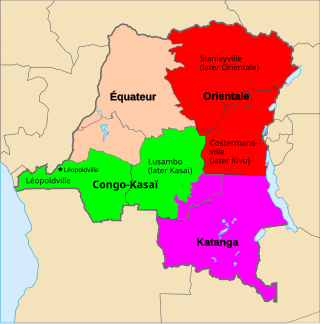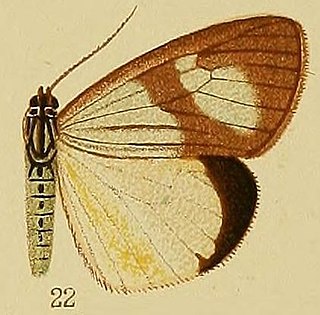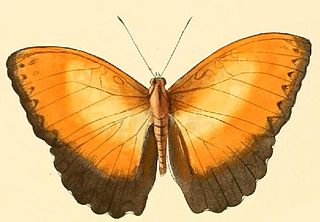
Katanga was one of the four large provinces created in the Belgian Congo in 1914. It was one of the eleven provinces of the Democratic Republic of the Congo between 1966 and 2015, when it was split into the Tanganyika, Haut-Lomami, Lualaba, and Haut-Katanga provinces. Between 1971 and 1997, its official name was Shaba Province.

The Democratic Republic of the Congo, also known as Congo-Kinshasa, DRC, DR Congo, or simply the Congo and known from 1971–1997 as Zaire, is a country in Central Africa. By land area, the DRC is the second-largest country in Africa and the 11th-largest in the world. With a population of around 112 million, the Democratic Republic of the Congo is the most populous officially Francophone country in the world. The national capital and largest city is Kinshasa, which is also the economic center. The country is bordered by the Republic of the Congo, Central African Republic, South Sudan, Uganda, Rwanda, Burundi, Tanzania, Zambia, Angola, the Cabinda exclave of Angola and the South Atlantic Ocean.

The president of the Democratic Republic of the Congo is the head of state of the Democratic Republic of the Congo and commander-in-chief of the armed forces.

Article 2 of the Constitution of the Democratic Republic of the Congo divides the country into the capital city of Kinshasa and 25 named provinces. It also gives the capital the status of a province. Therefore, in many contexts Kinshasa is regarded as the 26th province.

Bates's nightjar or the forest nightjar, is a bird species of the family Caprimulgidae, found in the rainforests of western Sub-Saharan Africa.

The Republic of the Congo was a sovereign state in Central Africa, created with the independence of the Belgian Congo in 1960. From 1960 to 1966, the country was also known as Congo-Léopoldville to distinguish it from its northwestern neighbor, which is also called the Republic of the Congo, alternatively known as "Congo-Brazzaville". In 1964, the state's official name was changed to the Democratic Republic of the Congo, but the two countries continued to be distinguished by their capitals; with the renaming of Léopoldville as Kinshasa in 1966, it became also known as Congo-Kinshasa. After Joseph Désiré Mobutu, commander-in-chief of the national army, seized control of the government in 1965, the Democratic Republic of the Congo became the Republic of Zaire in 1971. It would again become the Democratic Republic of the Congo in 1997. The period between 1960 and 1964 is referred to as the First Congolese Republic.

Chiromachla is a genus of tiger moths in the family Erebidae.

The following outline is provided as an overview of and topical guide to the Democratic Republic of the Congo:

Bebearia cutteri, or Cutter's forester, is a moth in the family Nymphalidae. It is found in Sierra Leone, Liberia, Ivory Coast, Ghana, Nigeria, Cameroon, Gabon, the Republic of the Congo, the Central African Republic and the Democratic Republic of the Congo. The habitat consists of wet forests.

Cymothoe beckeri, or Becker's creamy yellow glider, is a butterfly in the family Nymphalidae. It is found in Nigeria, Cameroon, Gabon, the Republic of the Congo, Angola, the Democratic Republic of the Congo, the Central African Republic and Uganda. The habitat consists of forests.
Scopula internata is a moth of the family Geometridae. It is found in the Democratic Republic of Congo, Gambia, Kenya, Malawi, South Africa, Tanzania, Uganda and Zambia.
Afrasura obliterata is a moth of the subfamily Arctiinae. It is found in Angola, Cameroon, Chad, the Republic of Congo, the Democratic Republic of Congo, Gabon, Ghana, Kenya, Nigeria, Sierra Leone, South Africa, Togo and Uganda.
Micralarctia punctulatum is a moth of the family Erebidae. It was described by Hans Daniel Johan Wallengren in 1860. It is found in Angola, Botswana, Cameroon, the Democratic Republic of the Congo, Eritrea, Ethiopia, Ghana, Kenya, Malawi, Mozambique, Namibia, Niger, Nigeria, Senegal, South Africa, Tanzania, Gambia, Uganda, Zambia and Zimbabwe.
Afrowatsonius marginalis is a species of moth of the family Erebidae. It is found in the Republic of Congo, the Democratic Republic of Congo, Ghana, Guinea, Ivory Coast, Malawi, Nigeria, Senegal, Sierra Leone and Togo.
Chiromachla leuconoe is a moth of the family Erebidae. It is found in the Democratic Republic of Congo, Ethiopia, Kenya, Malawi, Mozambique, South Africa, Sudan, Tanzania, Uganda and Zambia.
Chiromachla perspicua is a moth in the family Erebidae. It is found in Cameroon, the Democratic Republic of Congo, Equatorial Guinea, Gabon, Ghana, Guinea, Nigeria, Sierra Leone, Togo, Uganda and possibly Kenya.
Chiromachla restrictum is a moth of the family Erebidae. It is found in Democratic Republic of Congo, Ethiopia, Ghana, Kenya, Nigeria, Tanzania and Uganda.
Podomachla apicalis is a moth of the family Erebidae. It is found in Angola, Cameroon, the Republic of Congo, the Democratic Republic of Congo, Equatorial Guinea, Eritrea, Ethiopia, Gabon, Ghana, Kenya, Liberia, Malawi, Mozambique, Nigeria, Sierra Leone, South Africa, São Tomé & Principe, Tanzania, Togo and Uganda.

Negera natalensis is a moth in the family Drepanidae. It was described by Felder in 1874. It is found in Cameroon, the Central African Republic, the Democratic Republic of Congo, Gabon, Ghana, Ivory Coast, Nigeria, Senegal, Sierra Leone, South Africa, Tanzania, Gambia, Uganda and Zambia.











